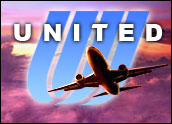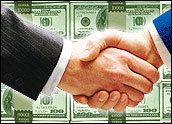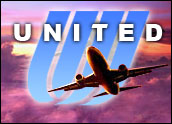
United Airlines was my Internet destination this week, as I continued samplingtravel-planning Web sites for the E-Commerce Times.
The first item to catch my eye was an unusual graphic. It was neither a 1) plane 2) automobile 3) hotel nor 4) iconic celebrity hawker.Instead it was a stylized drawing of a woman’s outstretched leg with a big bow on her ankle. What message could this possibly convey? As it turned out, it was simply United’s way of illustrating its holiday fares promotions; a design element that took me by surprise after weeks of reviewing travel Web sites that appeared to give little thought to layout or aesthetics. I hadn’t even tried out United’s fares or features, but already I was willing to give it points for originality.
Not for long, though. The three-panel layout could have been enlarged for easier viewing — especially the field to enter flight info on the left hand side. The right hand side could be safely ignored, at least by me: It was devoted to its Mileage Plus program, and I wasn’t a member.
Offer After Offer
I did pause at the Mileage Plus section long enough to note an intriguing offer: United was promoting a discount for flights in 2010 based on the number of flights a passenger booked for the remainder of 2009. One flight would mean a discount of 5 percent on a flight taken in 2010, while two would mean a discount of 10 percent, and so on.
That was not the only offer on display. As I navigated back to the main page again, I saw the discounted 2010 fares offers had been replaced with another deal: Premier Baggage, which at US$259 was apparently aimed for high-volume travelers. For that amount, a passenger and up to eight companions could check up to two standard bags each without fees.
I navigated back to the main page a third time, and again, I found a new offer — this time for 1,200 mileage points for a purchase of Bose acoustic noise-canceling headphones at a retail price presumably revealed to frequent flyers during the checkout process. I was beginning to like the way United presented its information: no cluttered-filled columns of deals spelled out in small print.
If you’re in a whimsical mood with time to spare, it might be fun to keep going back to the home page to see what deal comes up next. I have to wonder, though, how much is missed by travelers who just navigate to the main page to book a ticket and don’t tinker around.
As I examined the multiplying offers, I noticed that the graphic that initially caught my eye had been replaced by an attractive light blue illustration promoting special deals in Hawaii — eye-pleasing enough that the smaller-than-necessary frame for displaying content and the heavy promotion of United’s frequent flyer programs on the main page were forgivable.
Mix and Match Itinerary
Getting down to business, I went through the routine of booking a flight from Baltimore (BWI) to San Francisco (SFO) departing Dec.1 and returning on Dec. 15, 2009. I was stunned by the results: Prices ranged from US$400 to $583 to $698. I have found flights for just a little more than half that amount on aggregator sites, although not necessarily during the holiday season.
After recovering from the sticker shock, I moved on, noticing another interesting design element on the United site. Instead of the cumbersome mode many travel sites use for planning round-trips — booking departing and return flights separately, which requires users to toggle back and forth between confusing lists of options — United lined up my choices in two columns.
On the left were the flights from Baltimore to San Francisco; on the right were return flights from San Francisco to Baltimore. Each flight occupied its own box; I could design my trip by clicking on a departing box and then a returning box, lighting them up like the squares on a TV game show.
That $698 flight? It was a 6:50 a.m. departure from BWI with a 3:59 p.m. return from San Francisco. Clicking up the departure column while humming the Jeopardy show theme song, I found I could shave more than $250 off the price and still keep that 3:50 p.m. departure time. All I needed to do was leave on the 6 a.m. flight to score a $435 ticket.
Choosing 6 a.m. flights both coming and going netted me a $400 ticket, which worked for me. I proceeded to the checkout and, some $431 lighter, I was good to go.
I checked out the hotel selections on the dates I would be in San Francisco, not expecting much — this was an airline’s Web site after all. Again I was surprised — but pleasantly. I found a $99 room at the Sheraton on Fisherman’s Wharf (despite years of visiting the city, I’m still a sucker for the tourist attractions). With an additional $18.70 in taxes and fees, my grand total for the two weeks was $1,647.80 — a special e-rate, the site informed me.
A quick look at United’s customer commitment policy showed me a friendly, if vaguely worded, 12-point promise. The vagueness disappeared when I clicked on each point, uncovering a page of straightforward language (no legalese there) explaining each point in greater detail.
Point 8, for example, covered the dreaded trapped on a stalled plane for hours scenario: “In the event of a lengthy delay, United has contingency plans to provide food, water, restroom facilities and access to medical treatment for customers onboard an airplane,” the site promised.
Bottom line for United: Its transparent and fun-to-use flight-planning feature helps uncover the cheapest options, but you’ll want to do a reality check with an aggregator to make sure another airline doesn’t have an even-better deal.
























































Social Media
See all Social Media